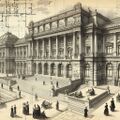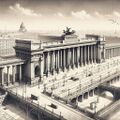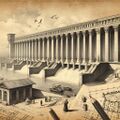Restauración Nacional
The Restauración Nacional (National Restoration) is the period in the history of Pelaxia between 1922 and 1956, when the military and free officers party governed the country uninterruptedly for 32 years. It includes the government of five different presidents affiliated with the party, mostly army generals. This period marked a before and after in the history of Pelaxia, due to the numerous changes that Benedicto Álvaro Camargo, Jacobo Bras and Diego Arencibia introduced in the country, both social and economic.
The Restoration Revolution marked the end of the Second Republic with the dismissal of President Mateo Parras, the revocation of the Constitution of 1877 with the aim of establishing a new constitutional order, the dissolution of the Federal Parliament; the federal intervention in the provincial governments and the change in the political scenario with the suppression of the electoral hegemony of the socialist party.
Phases
Normalization (1922-1936):
The period of normalization under Camargo and Blasco, during which both ruled by decree as Heads of the Junta of Generals, a position established by the Revolution, pending the adoption of a new constitution for the country. This period was initially supposed to last no more than 2 years, but internal conflicts within the army and navy prevented the realization of a consensual national project. The first period of government was marked by the political persecution of the socialist party and the suppression of unions through constant military interventions. Urban militias of free and voluntary officers were formed, functioning as paramilitary units of the Castrense Party itself.
Camarguism, the hallmark of the Restoration period:
Governmental authoritarianism. The regime claimed to be limited by law and Catholic morality, supported by a military institutionalism vested in a National Council, which was the final source of governmental decisions, and where political opposition was severely prohibited.
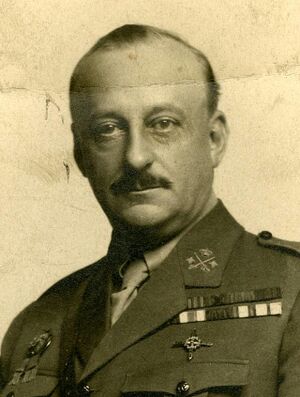
Religious morality It was opposed to political liberalism, despite the existence of a National Council (with legislative functions) and a Corporate Chamber (with merely consultative functions), with restricted freedom of expression. Nevertheless, both the Chamber and the Assembly only represented sectors that supported the regime. Unanimity was the norm in these bodies, as they were composed exclusively of regime sympathizers and members of the National Restoration Party. In this regime, the Government controlled both the executive and legislative powers (able to issue decrees that supersede laws passed by the National Council), with these powers being strongly centralized and reinforced in the hands of the Chancellor, who unilaterally decided the fate of the nation.
Political control A prior censorship service was established for press publications, radio, and television broadcasts, both national and foreign, prohibiting all criticism of the process’s doctrine and ideology, while defending “morality and good customs.” The regime relied on political propaganda to spread "good customs," as well as the doctrine and ideology defended by the Council of Generals.It also relied on youth organizations to impose the regime's ideology on young people: obedience and respect for the "leader," insisting on absolute loyalty to the Republic. A repressive political police force, omnipresent and wielding great power, repressed selectively, never being held accountable for mass crimes. Furthermore, the regime had paramilitary organizations (Guardia de Custodes) to protect itself from opposing ideologies, primarily communism.
An anti-communist and anti-Cahiravian rhetoric and policy prevailed, both internally and externally. The regime was highly conservative, attempting to control modernization and avoid globalization, as the Church feared these phenomena would destroy the nation’s religious, cultural, and rural values. Censorship also prevented discussions on topics such as feminism, sex education, and the importation of customs from the rest of the world.
The educational system was controlled (with a nationalist and ideological focus) and centered on the exaltation of national values (historical past, irredentism, religion, tradition, customs, etc.), along with the teaching and dissemination of state ideology to the youth. The regime was particularly suspicious of people with differing political views, especially if they also had a high level of education.
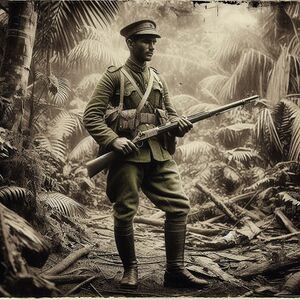
Irredentism A nationalist and colonial project aimed to keep vast territories, spread across several continents, under the shadow of the Pelaxian flag, with an increasing level of irredentism and expansion. In this regard, Pelaxian colonialism was portrayed as a victim of Caphirian expansionism on the continent.
Corpotativism A capitalist economy was controlled and regulated by cartels, which held great privileges, established and supervised by the Government, which was wary of innovation and development. The regime only allowed the opening of the economy and the regulated entry of foreign capital at a later stage in its history, in the 1940s, developing infrastructure (highways, railways, bridges, schools) and the Pelaxian economy (mainly the chemical and metal-mechanical industries, tourism, transportation, and the energy sector).
The New Pelaxia (1937-1947)
The period of the 1936 constitution, when, after the approval of the new constitution by the Constituent Assembly, Jacobo Bras was elected by the assembly, under the transitional provisions of the constitution, as Federal Chancellor, alongside a National Council, elected by a National Committee of the Castrense Party. Jacobo Bras would promote the military industry and the irredentism previously expressed by Camargo, in the context of the Great War.
The National Democracy (1948-1956)
Finally, the last period towards democratization began when Diego Arencibia, leader of the Blue faction of the army and supported by the Navy, imposed a new government through an authoritarian coup d'état and dissolved the National Council, assuming dictatorial powers with the aim of reforming and modernizing the State and administration. Arencibia would form a new party within the Restoration movement, the National Democracy. The final stage of the National Democracy was led by Federico Pedro Olmos, who facilitated the transition by calling political leaders from the country's main forces, following the August 1954 uprising.
Politics

The only official political party authorized to participate in elections during the process was the Restoration Party. The party, founded by military officials and members of the country's conservative institutions, became the primary arena to resolve the centrifugal forces of the conservative movement of this period. From the first period of normalization, the roles of Prime Minister and Chancellor were merged into a single figure supported by the National Council. During this period, only two electoral plebiscites were held for the election of the Federal Chancellor, with voting restricted to adult men who had completed military service and property owners. The National Council, a legislative entity, was delegated by the National Committee of the Castrense Party. This Council consisted of up to 120 members at its peak, and its selection was based on the territorial partition of the country and its electoral districts, heavily focusing on professional and technical merit. It included mainly military personnel, engineers, lawyers, ecclesiastical members, and members of outlawed political parties, among others.
Economy
The main issue facing Pelaxia by 1920 was a deep decline in economic activity, exacerbated by rampant inflation that had severely devalued the currency. The national industry was inherently dependent on foreign currency to finance its production, which was oriented toward the domestic market, while the country's primary source of foreign currency came from agricultural exports. During his two years in power, Camargo managed to balance the national budget and stabilize the currency, thanks to a stringent policy of national administration adjustments and defunding of unions and leftist organizations. By restoring order to the national accounts, enforcing austerity, and cutting unnecessary expenditures, Camargo produced the first of many budgetary surpluses, an unparalleled novelty in Pelaxia.
The economic period of the Restoration was marked by three programmatic axes that underpinned macroeconomic stability and significant economic growth: Five-Year Plans: The Restoration period borrowed the concept of five-year government plans from previous socialist administrations. Five such plans were implemented during the Restoration, each focused on specific productive and economic objectives, ranging from price stabilization to heavy military industrialization incentives. Bank Nationalization: One of the first actions of the National Council was the nationalization of the banking sector, with the aim of granting the state full control over the strategic financing of national projects. Productive Reform: The productive reform involved a new process of disciplining the labor sectors, including both the prohibition of unionization and the elimination of the minimum wage. This reform also included a restructuring of the secondary education system with the creation of new technical and industrial schools.
Culture
Symbolically and philosophically, the restoration process meant a reconstruction of the image of the modern man in Pelaxia. In contrast to a traditional liberal man who had his heyday in the second half of the 19th century, the man of the restoration was physical, industrial, urban, a body molded for the service of the nation against its external and internal enemies. The economic engine of his progress and transformation, from a non-classist but nationalist perspective. This man is a figure guided by impulses, in opposition to the intellectualism and parliamentarism of the liberal man. A catalytic figure, of action and the most guttural passions.
One of the main symbolic contradictions of the period is how Catholicism and the safeguarding of traditional values of the period end up conceiving a figure of a subject who ends up being so in touch with his most brutally materialistic condition.
One of the main works that analyzes the construction of subjectivities during the restoration period is “XXX” by “XXX”. In this work, the author postulates that unlike other proto-fascist and corporatist processes, the restoration process faced the difficult task of demobilizing large formations of unions and unionized workers that had formed in the previous socialist period. In this sense, the worker was not addressed in a classist or Marxist key, but based on his category of citizen to whom the fundamental task of rescuing a nostalgic idea of national glory was entrusted, by any valid means: work, civil service, military service, and ultimately, if necessary, death.
Cinema as a Tool of Propaganda
Cinema, in particular, was used as a mass medium to spread the ideals of the man of restoration. The films of the time focused on national heroes, military figures, and workers who embodied the virtues of the new citizen: disciplined, loyal, and willing to sacrifice for the good of the nation. The protagonists of these films were not intellectuals or political leaders, but ordinary men and women who, through hard work and devotion to the homeland, achieved greatness. Historical epics were produced that glorified military victories and great infrastructure works, building a narrative of national progress and power. Documentaries showed life in factories and fields, exalting physical labor and work as the pillars of Pelaxia’s resurgence. These cinematic productions not only entertained but also served as a means to educate the population in the values of the regime, promoting obedience and social conformity.
The Visual Arts and the Exaltation of the Body
In the visual arts, the representation of the human body acquired a new dimension. Idealized or abstract representations of the human being were abandoned in favor of a more realistic and powerful approach. The sculptures and paintings of the time exalted physical strength, showing muscular bodies, workers in the midst of their tasks, and soldiers in heroic poses. This aesthetic was not only a reflection of the new image of the Pelaxian man but also a way to counter what was considered the decadent intellectualism of the past. Additionally, artworks often included national and military symbols, merging the identity of the citizen with that of the nation. Art galleries and exhibitions were supervised by the state, ensuring that only works promoting the regime’s ideology received support and visibility.
Literature and Theater: The Narrative of Sacrifice
Literature and theater also aligned with the regime’s goals. The novels and plays published and performed during this period promoted stories of sacrifice, loyalty, and duty to the nation. Authors were encouraged to write about themes that exalted traditional values, family, religion, and above all, service to the homeland. The figure of the martyr, willing to give their life for the country, became a recurring archetype. These narratives sought to demobilize any kind of classist or revolutionary thought that still persisted from previous periods. Instead of confronting social classes, the literature of the restoration appealed to a nationalist unity, where all citizens, regardless of their origin, were called to contribute to the nation’s rebirth.
Architecture and Urban Planning
-
Plan for the Biblioteca de la República
-
Sketch for the Puerta de Jomagás
-
New dam of Font
The Materialization of Power
Architecture during the restoration period also reflected the ideals of the regime. Large government buildings, factories, and monuments were constructed to symbolize the strength and permanence of the state. Monumentality and the use of durable materials such as stone and marble were common, emphasizing the idea of a strong and immutable state. Urban planning was directed towards creating spaces that facilitated organization and social control, such as large avenues for military parades and plazas for public events. In summary, the arts and cinema during the restoration period in Pelaxia not only served as means of entertainment but also as strategic tools of propaganda and ideological education. Through them, the regime built and disseminated the image of the new citizen, aligned with nationalist values, prepared for action and sacrifice in the name of national glory.
Characteristics of Monumentalist Neoclassicism in Pelaxia
- Monumentality and Grandeur: The architecture of the period was characterized by the construction of imposing and massive buildings. Each architectural work was intended to convey the idea of power, permanence, and authority. Government buildings, palaces, and public institution headquarters were designed to inspire respect and admiration, both for their scale and design.
- Symmetry and Proportion: True to the neoclassical spirit, the buildings followed strict symmetry and classical proportions. The facades were balanced, with columns, pediments, and friezes inspired by Greco-Roman architecture. This symmetry symbolized the order and stability that the regime sought to impose on society.
- Use of Durable Materials: The use of solid and durable materials such as marble, stone, and granite was preferred, not only giving an air of robustness to the structures but also symbolizing the durability and firmness of the state.
- Reinterpreted Classical Elements: Although inspired by classical architecture, Monumentalist Neoclassicism in Pelaxia introduced variations that emphasized grandeur. Columns could be thicker, pediments higher, and friezes more detailed, with national or military motifs highlighting the power of the state.
- Public Spaces for Social Control: Urban planning of the time was also influenced by this trend. Large public squares, avenues for parades and official events, and commemorative monuments were designed to both glorify the regime and exercise social control, ensuring that the masses gathered in monitored and organized spaces.
- Military and Nationalist Ornamentation: Many buildings were decorated with national symbols, coats of arms, and military motifs such as laurel wreaths, swords, and shields. This not only beautified the structures but also reinforced the regime’s ideology in the daily lives of citizens.
Education
Education became a means to instill the values and principles of the regime in Pelaxian youth. From the early stages of schooling, students were exposed to a historical and cultural narrative that glorified the state, its leaders, and the idea of a powerful and unified Pelaxia. A worldview was promoted in which personal sacrifice for the nation was the highest duty of any citizen. Physical education classes and pre-military training became essential components of the curriculum. Students, from a young age, were instructed in rigorous physical disciplines, and in many cases, basic military training programs were implemented. The purpose was to prepare the youth not only for the defense of the nation but also to integrate into a disciplined and obedient society.
In line with the vision of a society oriented towards productivity and industrial development, technical and vocational education was promoted. Technical schools received a strong boost, with the aim of training skilled labor to support the country’s industrial and military growth. Specific programs were established to train young people in industrial, agricultural, and military trades, depending on the needs of the state. Despite the regime’s materialism and pragmatism, the Catholic religion maintained a place in the educational system, but its teaching was carefully controlled to avoid fostering questioning of the state.
Religious education was oriented towards promoting traditional values that aligned with the regime’s objectives, such as obedience, humility, and respect for authority. Special schools and academies were created for the training of the regime’s elites. These educational institutions were reserved for the most promising students, who were trained not only in the arts and sciences but also in the doctrine of the regime, with the intention of preparing the future leaders of the state.
